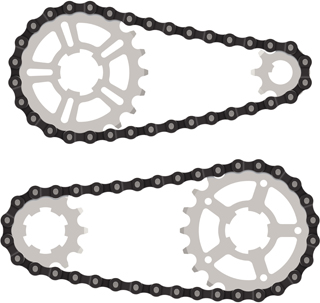Cyclists: Compact or Conventional Gearing?

If your cycling routes involve many climbs that make it difficult to maintain a reasonable cadence, you may find it better to switch to a bike with compact gearing. Compact drivetrains were originally developed by mountain bike component manufacturers to reduce the size of the chain rings and spider in cheap, heavy cranksets in order to reduce the weight of bikes. Today, compact drivetrains are embraced by cyclists for their ability to provide riders, especially non-professional cyclists, with a lower gear selection, which makes hill climbing easier while maintaining speed.
Compact Gearing vs Conventional Gearing: The Difference is in the Cranks
What makes compact gearing different from conventional gearing is the variation in chain ring sizes. Compact gearing was originally made with a large ring of 50 teeth and a small ring of 34 teeth, along with an 11 by 23-tooth cassette. While this sizing remains the most common, compact gearing is also available in sizes 50 by 36, 52 by 36, and 48 by 34, with various rear cassette options. In contrast, standard gearing is typically 53 by 39 with a 12 by 25-tooth cassette, although some variants of this can have either a small ring of just 38 teeth or occasionally a large ring of 52 teeth.
While the cranks used for compact gearing and conventional gearing are visually similar, they do make for a different ride. For example, cycling at 80 RPM with compact gearing can allow you to reach a speed of 28.4 miles per hour while the standard-gear rider can only cycle at 27.8 miles per hour. And this is just one of the ways compact cranks can give riders an advantage over standard gearing.
When climbing with a 23-tooth cog, you will reach a speed of 9.2 miles per hour, a slightly slower and easier pace than is achieved with the standard setup, where you will not be able to ride slower than 9.8 miles per hour if you are to maintain 80 RPM. Even better still, if you pair the compact gearing with an 11 by 25-tooth cassette, you will be able to ride at just 8.5 miles per hour at 80 RPM.
Deciding between a Compact or Conventional Crankset
All the above being said, amateur riders will experience no difference between the two gearing types until they reach an extremely high or low gear when riding flat. This is because non-professional riders typically cycle at around 20 mile per hour, which puts them on the large chain ring near the middle of the cassette. Few solo riders can stay on top of a compact 50 by 11 gear on level ground, while only the top cyclists in the world can maintain a 53 by 11 on the flat for any length of time. Therefore, unless you have a very high fitness level, either option will be the same for riding flat or rolling terrain.
To sum up, consider a compact crankset if:
- You struggle to turn over standard cranks as the strongest cyclists in your group cycling rides are able to do.
- There are large differences in terrain on your routes, as you can change cassettes to suit your ride much more easily than cranksets.
- Your rides feature a lot of steep climbs.
However, consider standard gear cranks if:
- You are strong enough to turn the higher gears while maintaining a reasonable cadence.
- You compete in races and need 53 by 11 cranks to complete your sprint finish.
- You do not often cycle routes with climbs that require use of the lowest gears.
The choice between compact and conventional gearing, therefore, really comes down to how much effort you want to exert in climbs. Compact gearing will reduce your suffering if you are an amateur cyclist, although very strong riders may benefit from the higher gears available with a standard crankset.

